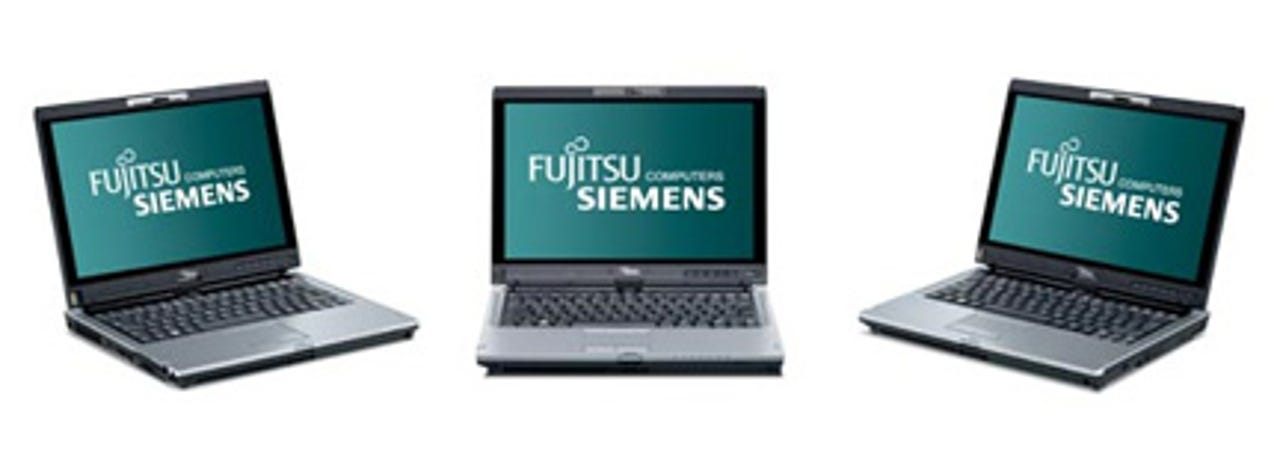Fujitsu Siemens LifeBook T5010


Fujitsu Siemens' LifeBook T5010 comes from the same stable as the T1010 that we reviewed earlier this year. Like the T1010, it's a relatively large and heavy convertible Tablet PC; differences include an active touch-screen rather than the T1010's passive unit, a solid-state hard drive option and a wider range of processors.
Design
The LifeBook T5010 looks more businesslike than the white-clad T1010, with its black lid — although there's still plenty of white surrounding the keyboard and on the wrist rest.
The LifeBook T5010 is a business-focused 13.3in. Tablet PC weighing 2kg and costing £1,624 (ex. VAT).
Although the 2kg T5010 isn't exactly a featherweightt, its 13.3in. screen does provide plenty of working space. The 1,200-by-800-pixel resolution is par for the course and viewing angles are good, both vertically and horizontally. The screen uses an active digitizer, so you'll have to use the stylus for touch-based navigation and handwriting recognition: this lives in a housing on the front right edge of the notebook.
At 31.9cm wide by 24.4cm deep by 3.65-3.85cm thick, the T5010 is the same size as the T1010, and the casings of the two notebooks are also very similar in design. Both share a solid clasp that holds the lid and base sections together when the notebook is in Tablet PC mode and in transit. Build quality is generally robust and there's very little flex in the lid section.
Unlike its T1010 sibling, the T5010 uses an active digitiser for the touch-screen, so it will only work with the provided stylus.
Fujitsu Siemens has done a good job with the keyboard, which is spill-proof, exhibits almost no flex, and has large keys with good travel and audible feedback. Typing at speed is no problem. The two-button touchpad on the wrist rest incorporates vertical scrolling.
As with the T1010, the horizontal scroller is on the screen surround. This makes using scrolling features a bit of a disjointed task. We can see why Fujitsu Siemens wants to put a touch-controlled scroller on the screen surround but we think vertical and horizontal scrolling should be available on both the touchpad and on the screen surround.
Blue status LEDs sit on the very front edge of the wrist rest, where they are visible when the notebook is closed, in Tablet PC orientation and in notebook mode.
Controls embedded in the lid section provide access to plenty of functions in Tablet PC mode. The on/off switch is here, as is the fingerprint sensor. Two microphones sit on the bottom long edge of the screen, while the top edge houses the very small lens of a 1.3-megapixel webcam. A bank of five buttons accesses features like screen rotation and the Windows Mobility Center.
Features
Fujitsu Siemens offers a wide range of Intel Core 2 Duo processors to power the T5010, from the 2.26GHz P8400 to the 2.8GHz T9600. Our review sample had the mid-range 2.4GHz P8600 and 2GB of RAM. The maximum RAM capacity is currently 4GB, although 8GB is in the pipeline with future 4GB memory modules. Graphics are handled by the GMA 4500MHD module integrated in the Intel GM45 Express chipset.
Windows Vista Business was preinstalled on our review system, but there's a downgrade option to Windows XP Tablet PC Edition 2005 if required.
Wireless connectivity comes in the shape of Intel's WiFi Link 5300AGN (802.11a/b/g and Draft-N) and Bluetooth 2.1; mobile broadband (via a Sierra Wireless MC8790 module) is available as an option. Gigabit Ethernet is available for wired connection.
There are several hard drive options. Our review sample had a 160GB hard drive, but you can also choose 320GB or 120GB hard drives or a 64GB solid state hard drive. The physical drives benefit from a shock protection system.
The optical drive sits in a modular bay on the right side of the system. This can be used to accommodate a second hard drive, a second battery or a space saver.
The front edge is clear of ports and connectors, while the right side houses just the optical drive. On the back are two USB 2.0 ports, the Ethernet (RJ-45) port and, under a hinged flap, a VGA connector for an external monitor. If you choose the mobile broadband option, the SIM card slot is also under this flap.
The left edge has a third USB 2.0 port, a FireWire (IEEE 1394) port, a pair of audio jacks, an ExpressCard slot, a SmartCard reader and a reader for SD- and Memory Stick-compatible media.
Performance & battery life
The Windows Experience Index (WEI) for the LifeBook T5010 was 3.7 (out of 5.9). In general its performance was impressive, and it consistently out-performed or equalled the last notebook we reviewed with the same processor, HP's EliteBook 6930p.
The top score of 5.6 was for RAM (Memory operations per second), while Processor (calculations per second) and Primary hard disk (Disk data transfer rate) both did well with ratings of 5.3. The bottleneck, as usual, was the graphics subsystem: Graphics (desktop performance for Windows Aero) scored 3.9 and Gaming Graphics (3D business and gaming graphics performance) brought up the rear (and provided the overall WEI rating) with 3.7.
Fujitsu Siemens claims that the provided 6-cell battery will keep the LifeBook T5010 going for 6 hours, or 9 hours if you add a second battery in the modular bay.
We chose the Balanced power plan and asked the notebook to play a DVD movie for as long as possible from the standard battery. Under these conditions, we got just 2.5 hours of video playback from a full battery charge. When simply using the notebook for everyday working we got closer to 4 hours of life.
Conclusion
The Fujitsu Siemens T5010 is a well-made convertible Tablet PC with a sturdy casing and a comfortable keyboard. It's a little heavy for extended use in tablet mode, but benefits from a 13.3in. screen and decent performance.